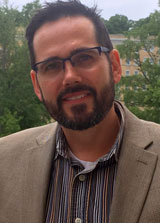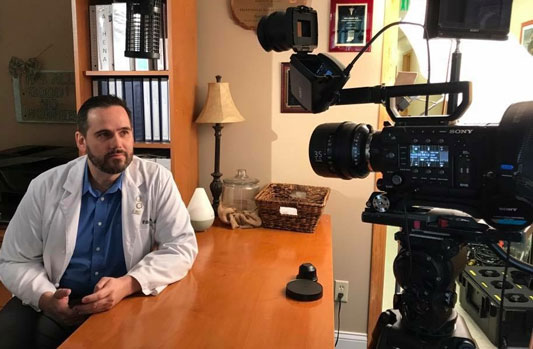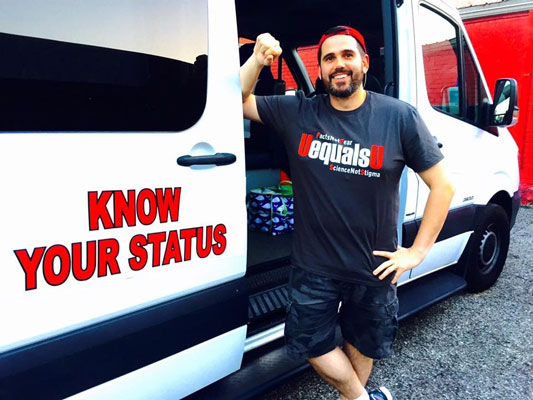Nov 28, 2018
Responding to the HIV Crisis in Scott County, Indiana: Q&A with Dr. William Cooke
by Jenn Lukens
 In 2015,
Scott County, Indiana, experienced the largest HIV
outbreak in rural America's recent history and a sharp
increase in hepatitis C cases. Fueled by the worsening
opioid epidemic, finding solutions for recovery seemed
daunting. The town of Austin's only physician at the
time, Dr. William Cooke, took action to bring healing and
hope to his community of 4,200 people and its surrounding
county.
In 2015,
Scott County, Indiana, experienced the largest HIV
outbreak in rural America's recent history and a sharp
increase in hepatitis C cases. Fueled by the worsening
opioid epidemic, finding solutions for recovery seemed
daunting. The town of Austin's only physician at the
time, Dr. William Cooke, took action to bring healing and
hope to his community of 4,200 people and its surrounding
county.
He and his staff at Foundations Family Medicine personally knocked on doors and made phone calls to connect each HIV-positive person they knew to their newly launched HIV, hepatitis C, and opioid/substance use disorder services. Since the outbreak, the county has seen drastic improvements in viral suppression rates, outdoing national rates by a large margin.
Dr. Cooke also runs the hospitalist program at Scott Memorial Hospital in nearby Scottsburg, manages three school-based clinics, and teaches at Marian University College of Osteopathic Medicine and Indiana University School of Medicine. Dr. Cooke and his wife, Melissa, have six children.
Awards and Recognition
- 2019 Family Physician of the Year by the American Academy of Family Physicians
- Harold E. Hughes Exceptional Community Program Award by the National Rural Institute on Alcohol & Drug Abuse
- Selected as a clinical scholar by the Midwest AIDS Training and Education Center
- Became the first family practice physician in Indiana to be certified to administer hepatitis C treatment
- 2017 Indiana State Commissioner's Award presented by Dr. Jerome Adams
- 2017 Leonard Tow Humanism in Medicine Award by the Gold Foundation
- 2017 Vanguard Award by the Midwest AIDS Training and Education Center
- 2016 Indiana Family Physician of the Year Award by the Indiana Academy of Family Physicians
- 2016 Doc Hollywood Award by the Indiana Rural Health Association
- 2015 Indiana Harm Reduction Hero Award by the Rural Center for AIDS/STD Prevention's Project Cultivate
- 2015 National Harold E. Hughes Award for Exceptional Community Award
How did you come to start a practice in Austin, Indiana, and what has influenced your decision to stay?
Before I even went to medical school, I felt the calling to provide medical services in an underserved community. I say "community" on purpose because I wanted to be a part of a community: not just see patients from 9:00 to 5:00 and go home, but to really learn about a community, hear the needs, and then respond to those needs. Austin stood out because of its need for access to medical services. Since it was founded in 1853 up until the 1970s, Austin had a physician practicing in town. From the 1970s up until I opened my practice in 2004, there was no consistent healthcare in the town, so that compelled me to look closer at the community.
There's also this rich history in Scott County of collaborating to meet people's needs. I responded to that as well because I really believe that it takes collaborating with different sectors of a community to be able to wrap a person in the care that they need to live a healthy life.
I want to see Austin be the healthy community that it can and should be – a community where anyone would be proud to raise their children and a destination where people want to go. There is a lot to offer here: the charm of the downtown and the beauty of outdoors….I want to see this city shine the way it can and should. So that keeps me striving and moving and not giving up.
What does the situation in Austin look like now, compared to 2015 when the town was frequently in the national news? What has the journey from there to here been like?
It's always weird reading the coverage because, to me, it's just what I do. One of the more important things that I was able to accomplish early on was listening to the people who were in the midst of addiction and contracting HIV and then responding to those needs. At the same time, giving them a legitimate seat at our Get Healthy Scott County Coalition table so they could help drive what recovery looks like.
In doing so, our recovery groups have gone from having 30 people across the county to having over 300 people. We're seeing a decrease in hepatitis C rates when almost every other county in Indiana and across the country are seeing increases. We have a 76% viral suppression rate among those with HIV; nationally, it's at 49%, so we are well above that. People are interacting with the syringe service program: 86% of people who inject drugs are accessing the syringe service program, and that number goes up to 98% for those who also have HIV.
The story of what's happened over the last three years is really the story of people who are willing to take responsibility for their own health and the health of their community if they are given the opportunity to do so. And what we did here in Scott County has provided them the opportunity.
The story of what's happened over the last three years is really the story of people who are willing to take responsibility for their own health and the health of their community if they are given the opportunity to do so. And what we did here in Scott County has provided them the opportunity. It's not me or the coalition who did this. It's the people; it's the community of Austin that has responded in such an overwhelmingly positive way.

Being at the center of the HIV crisis has also brought in groups from around the nation to assist in the efforts. How have you helped manage the influx of help?
There's a phenomenon that occurs called the "tragedy of the commons," where different individuals or organizations sharing the same resource inadvertently end up using a common resource in ways that hurt other individuals or organizations. I've seen that occur here, and, in an area that has limited resources, that's not sustainable.
So, I had three principles that I felt every organization that came into the community needed to follow. The first was that everything needed to be patient-centered, not organization-centered; everything needed to be considered through the eyes of a patient. The second was that they needed to be directly linked to community resources so that, if another organization is already doing a service in the community, it's not replicated on a short-term basis.
The last thing was sustainability. Is what you are doing sustainable, or is what you are doing a flash in the pan that is going to go away? Sometimes, intense but short-term work hindered other organizations that were trying to do the work on a long-term basis. So being patient-centered, being directly linked to local resources, and sustainability: these didn't always happen, but sometimes they did.
You had an influence on the state's decision to legalize syringe exchange services for Scott County. What impact have harm reduction programs like this had on your community's healing?
A syringe service program offers an olive branch or a bridge into care for people who are disconnected, marginalized, and criminalized. One of Maslow's basic needs is safety. So, when people go to Hope to Others, Food 4R Souls, recovery community organizations, the syringe service program, to one of my mobile outreach community workers, or when they just come meet with me in the office, they need to know that the relationship is safe and they are not going to be turned away as less than human. They need to know that they are going to be seen as a person first, and then they are going to be provided access to the care that they need.
I've often said that where a community fails, addiction thrives. The reverse is also true: where a community thrives, health thrives.
I've often said that where a community fails, addiction thrives. The reverse is also true: where a community thrives, health thrives. That's what we have tried to embrace, that every single life matters and every single person deserves the opportunity to access health and to be healthy.
What strategies have you used to reach patients who are hesitant or unable to come to your clinic for HIV, hepatitis C, and substance use disorder/opioid use disorder testing and treatment?
I think being [in Austin] a little over ten years prior to the outbreak went a long way. I was already invested in the community, had shown myself to be approachable in a non-judgmental way, and was able to meet people where they were in life to help them.
Telehealth has also been really invaluable by supporting us through Project ECHO® and the development of our rheumatology clinic, diabetes clinic, and the hepatitis C/HIV clinic. I can also provide HIV care for a neighboring county's jail through telemedicine and support to school-based clinics in the county. I'm also able to support recovery centers from a telemedicine standpoint as well. Another key has been the community health workers whom I send into the community to meet with people and do testing. They can also connect with me wherever they are to speak directly to a patient through telehealth.
You are a certified HIV specialist and certified to administer treatment for hepatitis C. What are the challenges of treating so many patients with HIV or hepatitis C in a rural community, particularly when they have co-occurring substance use disorder? How have you overcome those challenges?
I believe that there is no other field that is better suited to respond to the needs of the community than family medicine doctors. Taking on patients with multiple chronic medical problems is not new to family medicine; that's what we are trained to do. We develop relationships that last a lifetime with people, and we understand how to help those people manage chronic conditions over their lifetime.
I believe that there is no other field that is better suited to respond to the needs of the community than family medicine doctors.
The challenge is being in a rural area without access to peers to draw on their knowledge or expertise. If you are in a large urban practice, you usually have a partner or maybe a specialist down the hall who you can run things past. In a rural area, you don't have that. I could look up the treatment algorithms for HIV, for substance use disorder, for hepatitis C. I could do the studies and come up with an evidence-based plan, but there's nuances that are missed because medicine isn't just a science; it's also an art. Through Project ECHO, I was able to meet with a group of specialists every week to discuss what I'm going through in a rural community. The experience has been indispensable, priceless – both from a knowledge standpoint and a resiliency support standpoint.
Through Project ECHO and the help of Joan Duwve at the Indiana State Department of Health, I was the first primary care provider in the state to become certified to provide hepatitis C care. I then worked with the Indiana University's Richard M. Fairbanks School of Public Health as an informal advisor in the development of a statewide hepatitis C ECHO clinic. Now, any primary care provider in the state can provide hepatitis C care, and I'm very proud of that.

What treatment options does your clinic and your community provide for patients who have substance or opioid use disorders?
I studied under a couple of addiction medicine mentors to gain the expertise in addiction medicine; I'm board-certified in addiction medicine now. I provide addiction care, self-counseling with patients, and dialectical behavioral therapy. We also do the evidence-based intervention SBIRT (Screening, Brief Intervention, and Referral to Treatment) in the clinic.
I work at a recovery center where I see patients on an inpatient basis to help them start their recovery. We do warm hand-offs with Centerstone Behavioral Health, which is housed in our building. LifeSpring Health System also sends a psychiatrist to visit once a week to help with services.
We administer Suboxone for our patients on a limited basis as well as Vivitrol (naltrexone). I treat alcoholism; I treat people with nicotine dependency; I help people wean off of their benzos (benzodiazepine) dependency, opioids, methamphetamine, and heroin. I'm also a certified MAT provider. So I've taken on a lot, but I have a lot of patients who are doing really, really well and I'm proud of each and every one of them.
The resistance you met at the start of your HIV, hepatitis C, and opioid efforts is not uncommon in many rural communities. What have you all done to help change mindsets and reduce stigma?
Being patient with people. It's not unreasonable for people to have a negative reaction to a crisis, so instead of closing doors that may provide opportunities for future relationships, we have dialogues with people. People want to understand things, but they are going to be close-eared if we just come off as a clanging cymbal.
It's not unreasonable for people to have a negative reaction to a crisis, so instead of closing doors that may provide opportunities for future relationships, we have dialogues with people.
There's an evidence-based behavioral change model called motivational interviewing – it's all about hearing where people are, asking questions, and sometimes providing information that they may not have. But you have to listen and ask questions before you can get to that point because, if you are just coming into that situation gung-ho with data, it's going to be overwhelming for them. Motivational interviewing is not just practiced with our patients, but also with other community members by inviting people in to be a part of the solution and not "building fences," as Robert Frost would say.
Opinions expressed are those of the interviewee and do not necessarily reflect the views of the Rural Health Information Hub.
